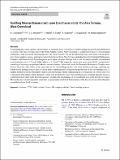Files in this item
Building Mesoarchaean crust upon Eoarchaean roots : the Akia Terrane, West Greenland
Item metadata
| dc.contributor.author | Gardiner, N. J. | |
| dc.contributor.author | Kirkland, C. L. | |
| dc.contributor.author | Hollis, J. | |
| dc.contributor.author | Szilas, K. | |
| dc.contributor.author | Steenfelt, A. | |
| dc.contributor.author | Yakymchuk, C. | |
| dc.contributor.author | Heide-Jørgensen, H. | |
| dc.date.accessioned | 2019-09-17T12:30:03Z | |
| dc.date.available | 2019-09-17T12:30:03Z | |
| dc.date.issued | 2019-03 | |
| dc.identifier | 261214853 | |
| dc.identifier | 594bd0ab-9e41-4d53-90dd-e67fdaf88010 | |
| dc.identifier | 85062077374 | |
| dc.identifier.citation | Gardiner , N J , Kirkland , C L , Hollis , J , Szilas , K , Steenfelt , A , Yakymchuk , C & Heide-Jørgensen , H 2019 , ' Building Mesoarchaean crust upon Eoarchaean roots : the Akia Terrane, West Greenland ' , Contributions to Mineralogy and Petrology , vol. 174 , 20 . https://doi.org/10.1007/s00410-019-1554-x | en |
| dc.identifier.issn | 0010-7999 | |
| dc.identifier.other | ORCID: /0000-0003-3465-9295/work/62311885 | |
| dc.identifier.uri | https://hdl.handle.net/10023/18486 | |
| dc.description | The Maniitsoq project is supported by the Ministry of Mineral Resources and Labour, Government of Greenland. NJG thanks Curtin University and Australian Research Council grant FL160100168 for financial support. | en |
| dc.description.abstract | Constraining the source, genesis, and evolution of Archaean felsic crust is key to understanding the growth and stabilization of cratons. The Akia Terrane, part of the North Atlantic Craton, West Greenland, is comprised of Meso-to-Neoarchaean orthogneiss, with associated supracrustal rocks. We report zircon U–Pb and Lu–Hf isotope data, and whole-rock geochemistry, from samples of gneiss and supracrustals from the northern Akia Terrane, including from the Finnefjeld Orthogneiss Complex, which has recently been interpreted as an impact structure. Isotope data record two major episodes of continental crust production at ca. 3.2 and 3.0 Ga. Minor ca. 2.7 and 2.5 Ga magmatic events have more evolved εHf, interpreted as reworking of existing crust perhaps linked to terrane assembly. Felsic rocks from the Finnefjeld Orthogneiss Complex were derived from the same source at the same time as the surrounding tonalites, but from shallower melting, requiring any bolide-driven melting event to have occurred almost simultaneously alongside the production of the surrounding crust. A simpler alternative has the Finnefjeld Complex and surrounding tonalite representing the coeval genesis of evolved crust over a substantial lithospheric depth. Hafnium isotope data from the two major Mesoarchaean crust-forming episodes record a contribution from older mafic Eoarchaean crust. Invoking the involvement of an Eoarchaean root in the growth of younger Mesoarchaean crust puts important constraints on geodynamic models of the formation of the discrete terranes that ultimately assembled to form Earth’s cratons. | |
| dc.format.extent | 5296692 | |
| dc.language.iso | eng | |
| dc.relation.ispartof | Contributions to Mineralogy and Petrology | en |
| dc.subject | Archean | en |
| dc.subject | Hf isotope evolution | en |
| dc.subject | North Atlantic Craton | en |
| dc.subject | Partial melting anatexis | en |
| dc.subject | TTG | en |
| dc.subject | QE Geology | en |
| dc.subject | GE Environmental Sciences | en |
| dc.subject | Geophysics | en |
| dc.subject | Geochemistry and Petrology | en |
| dc.subject | DAS | en |
| dc.subject.lcc | QE | en |
| dc.subject.lcc | GE | en |
| dc.title | Building Mesoarchaean crust upon Eoarchaean roots : the Akia Terrane, West Greenland | en |
| dc.type | Journal article | en |
| dc.contributor.institution | University of St Andrews. School of Earth & Environmental Sciences | en |
| dc.identifier.doi | https://doi.org/10.1007/s00410-019-1554-x | |
| dc.description.status | Peer reviewed | en |
This item appears in the following Collection(s)
Items in the St Andrews Research Repository are protected by copyright, with all rights reserved, unless otherwise indicated.

